(Click these to read Day One and Day Two!)
In the morning, to give my already tired legs a break, I decide to take the metro to Balard in the 15th which is close to Pont Aval, where the Seine exits Paris. The map makes it seem easy enough to walk to the last bridge, though when I arrive the area surrounding the metro station is a bit chaotic. I head off in what I know is the general direction of the Seine, following a herd of locals who get off a tram (a good rule to remember: when in doubt, follow the locals). We pass a bunch of modern buildings, a heliport(!), several tram stops. In the distance, I see a sign for the Microsoft building, which I know is right by the river. Finally, after about ten minutes of walking, I spot what I assume must be the river — a big gap between buildings and a highway — the last bridge — taking traffic over the gap. But the area is a mess of construction, and it takes me thirty more minutes just to figure out how to get on the second-to-last bridge (I’ll spare everyone the boring details of walking on shoulders and searching for crosswalks, though I am proud to report that I neither got arrested nor plowed over by crazy, French drivers).
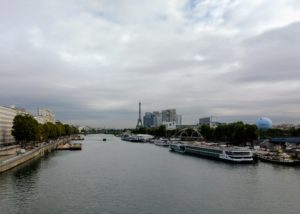
Finally, my zig zag resumes. I’m on the Pont du Garigliano, which links the 15th and 16th arrondissements. This is a newer, metal bridge that was constructed just over 50 years ago. I also have learned that conceptual artist, Sophie Calle (one of my current obsessions) has an installation here called, Le Téléphone, which is a telephone that’s sculpted in the shape of a flower; its only function is to receive calls from Ms. Calle. But the installation is nowhere to be found. I walk across the bridge. I walk back on the other side of the bridge. I walk back again. It’s not there. (I later learn that the installation was removed a couple of years ago due to vandalism. Damn.)
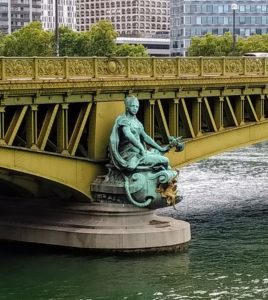
I resume my stroll. I’m heading back toward the city center, next crossing the interesting Pont Mirabeau. At the time of its construction, this metal bridge was the longest bridge and the highest bridge in crossing the Seine; now it’s considered an historical monument. The two piles of the bridge represent boats (one sailing upstream, the other down) with two sets of nifty statues, known as allegories, on each side of the bridge (one facing the Seine, the other the bridge).
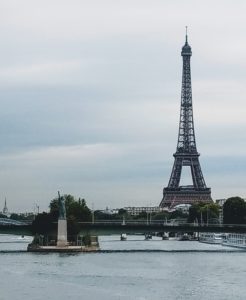
My next bridge is the Pont de Grenelle, which passes over the Île aux Cignes. I make a pitstop here, as I’m fascinated by this manmade island in the middle of the Seine. The island is uninhabited and small — picture a long rectangle. It’s a pretty tranquil setting, with a treelined walkway running from one end to the other and a workout area at one end. On the downriver tip stands the mini Statue of Liberty, which faces west, towards her counterpoint in the United States. As I’ve never visited the Statue in the US (shocking, I know), I stop for a visit then decide to resume my walk up the center of the island.
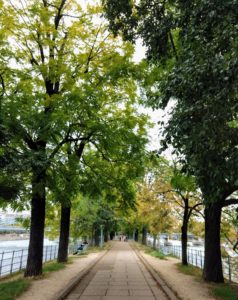
The island is so peaceful, so calm, it’s hard to believe that I am only a few feet away from the chaos of a massive city. There are a few visitors — mostly people working out or taking a leisurely stroll like me, a few tourists who came to see mini-LIberty — but for the most part the island is relatively empty. I pass under the Pont Rouelle, a rail viaduct, then gear up to head back to the left bank on the Pont de Bir-Hakeim.
You see. I know what’s coming. I have to walk past the Eiffel Tour. I don’t have anything against the monument. I’ve been to it before. I’ve been up it — twice, I think. But I know that it’s still summer and that there will be massive crowds of tourists and people selling plastic replicas of Le Tour Eiffel. Big crowds of tourists, especially when it’s hot out, give me such anxiety that I tend to avoid them whenever possible. (I recognize the irony in what I’m saying here; no need to point it out.)
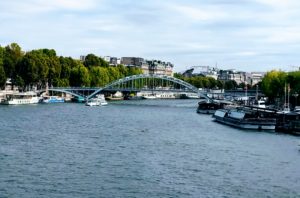
I quickly work my way through the crowd and then glide across the Pont d’Iéna (I suppose I should be coming from the right bank on the bridge, which makes more sense in terms of the logic of a grand entrance as it would drop me off just a few feet from the base of the Eiffel Tower. But again…Crowds. Summer).
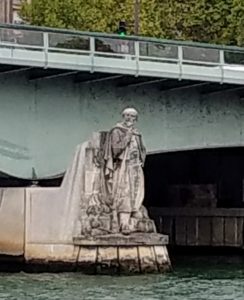
If you want good photos of the Eiffel Tower, head over one bridge. I work my way back to the left bank by crossing the footbridge, Passerelle Debilly, which was built to help with pedestrian overflow into Paris for the 1900 World’s Fair, and then I move on to the Pont de l’Alma. Interestingly, I learn after the fact that the original bridge here was used to measure the water levels of the Seine — based on whether or not the water level had reached the feet of The Zouave statue. The original bridge has been replaced, but the statue remains. (Sad bridge fact: this bridge is close to the Pont de l’Alma tunnel where Diana, Princess of Wales was killed in a car crash in 1997).
I’m so close to the end! One more bridge. The Pont des Invalides. In truth, I’m so focused on being finished that I don’t pay much attention to this one. As I cross the bridge, to my left, I can see the gold Fames on Pont Alexandre III. They’re calling to me (I knew there was a good reason that was my starting point; shiny things make for good motivation).
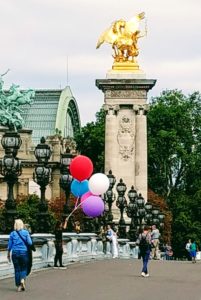
Let’s see. What do I know? I know that there are 37 bridges that cross the Seine in Paris and that it’s possible to walk over 33 of them. I know that bridges are way more interesting than I ever thought possible. I know that when you arrive at Balard metro that if you turn left instead of right as you exit you’ll be able to more directly get to the Seine. I know that I’m the type of person that will walk 39 minutes, one way, with rain clouds looming, to take a photo of a statue that I missed the first time. Though I guess I already knew that one.
Other than that, I suppose I could pontificate about a bridge being some sort of metaphor for life. But I won’t. There are no epiphanies here, no grand proclamations, no climatic moments. There is only, as Jake Barnes once said, the pleasantness of walking across a bridge in Paris. And sometimes finding a bouquet of balloons halfway.
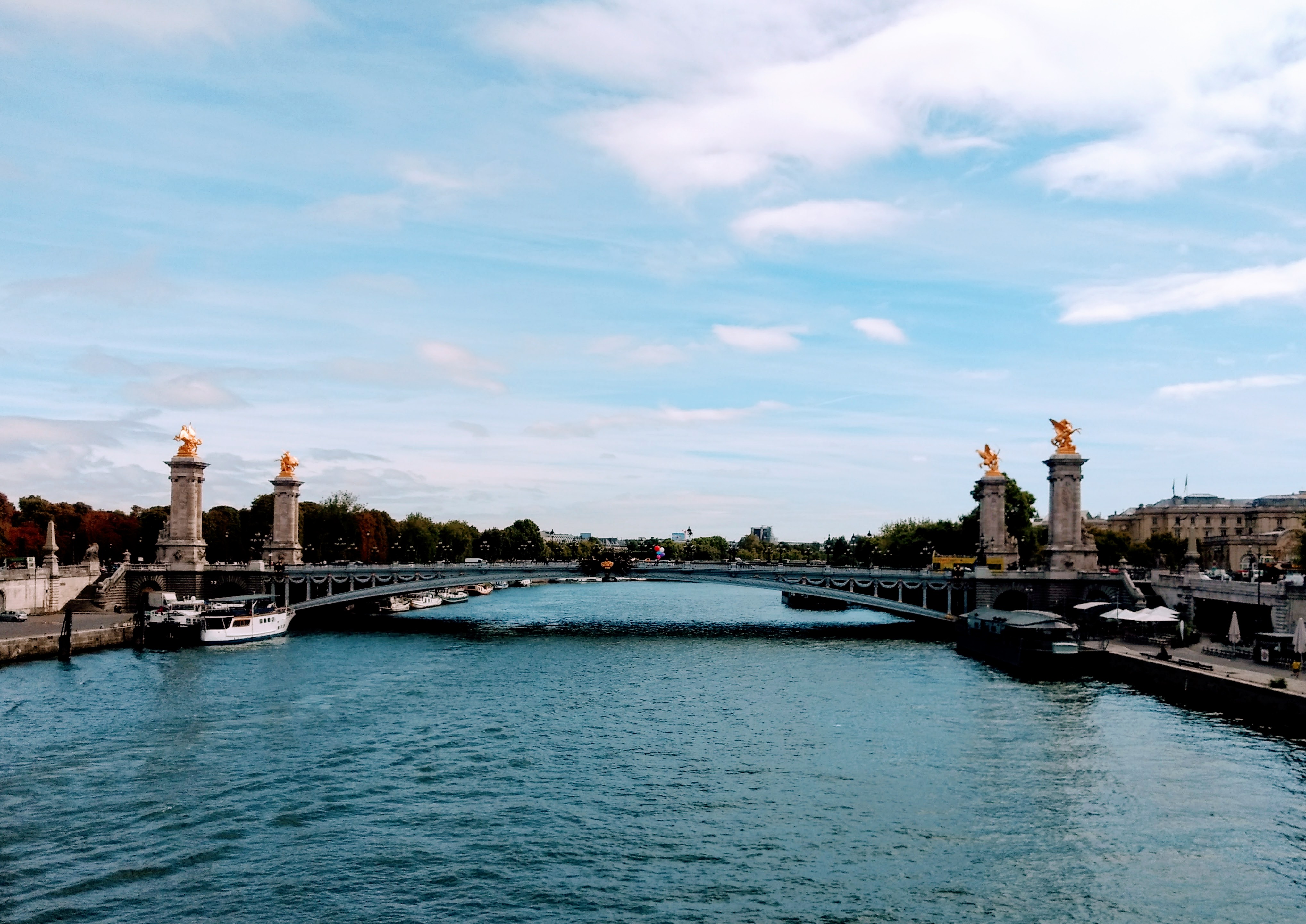



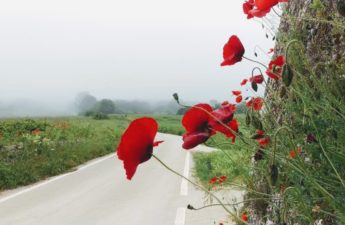
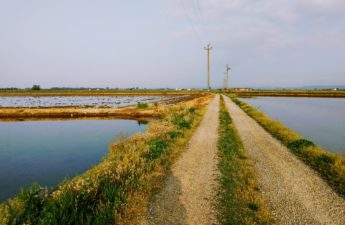
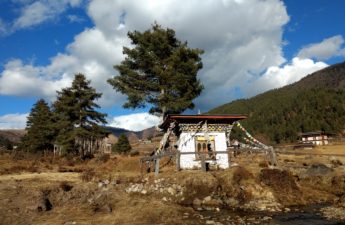
I am loving your bridge stories as you wander and wonder, kind of like i used to like doing. However, nitpicker me is wondering about this: do you mean ‘pylons’ or ‘piles’ here? The “two piles of the bridge represent boats (one sailing upstream, the other down) with two sets of nifty statues, known as allegories,”
In the reading that I’ve done, they’ve been referred to as piles. (Not being an expert in bridge construction, of course!) Ici en francais: http://paris1900.lartnouveau.com/ponts/pont_mirabeau.htm
There’s also a poem about the bridge that’s linked there!
I knew you liked shiny things!! What a lovely experience you seem to be having…I only wish I could walk alongside you. You need to buy a selfie stick, girl, and tourist it up, at least one day. I want to see your happy face. My favorite line in all your musings: “And it’s true. I can’t help but fall just a little bit in love with myself as I sit there, gazing out at the Pont des Artes.” I can’t help but love you too!
I will never buy a selfie stick! But when my mom comes to visit in a few weeks, we’ll do more touristy things. That would be a fun day though, and a fun story, to do all of the over-the-top touristy things I normally don’t do (ride that double-decker bus, buy tacky plastic objects, etc.) It can be fun in small doses.
Though nothing will beat OUR days in Paris, love!
Three amazing days with three amazing stories! I would love to cross-reference these with a map, so if you have one you can post, that would be great. Brian and I are taking notes for a future visit to Paris!
Pardon the Wikipedia link, but here’s where I found the list: https://en.wikipedia.org/wiki/List_of_bridges_in_Paris
I find that just the basic Google Map of Paris has them all if you zoom in and out. The article has links to most (all) of the bridges, with some general information (though the more fascinating ones I would search additionally).
When to Paris?
Oh, Paris is just a thought now, but we know we’ll be back there someday. No specific plans! And thanks for the link!